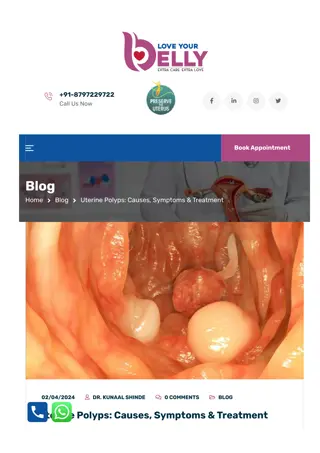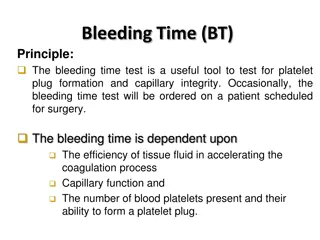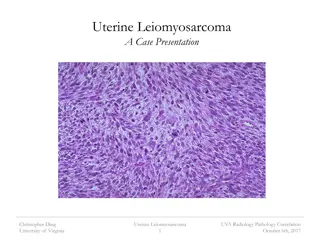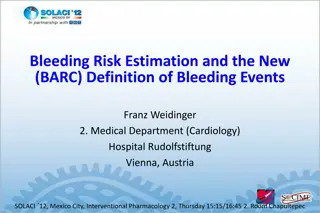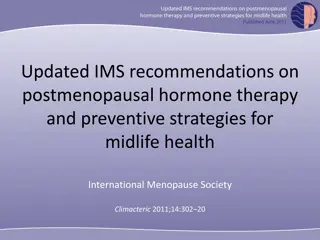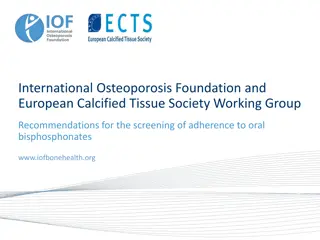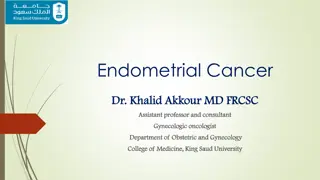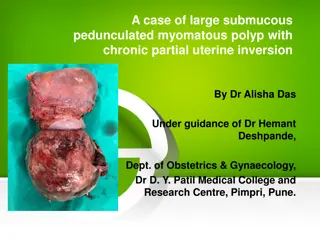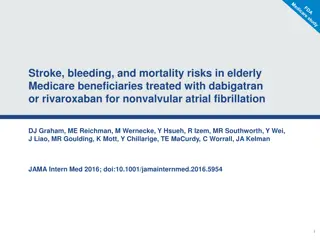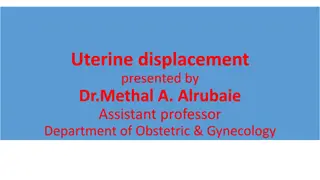Understanding Uterine Cancer and Postmenopausal Bleeding
Dr. Khalid Akkour, Assistant Professor of Gynecologic Oncology at King Saud University Medical City, provides insights on uterine cancer and postmenopausal bleeding. The structured OSCE discusses important aspects such as taking a focused history, age, ethnicity, past gynecologic and obstetric history, past medical history, allergies, social history, and family history. It also covers the causes of postmenopausal bleeding, including vaginal atrophy, endometrial polyps, endometrial hyperplasia, endometrial cancer, cervical cancer, and fibroids. Understanding the common causes of postmenopausal bleeding is crucial for diagnosis and management.
Download Presentation

Please find below an Image/Link to download the presentation.
The content on the website is provided AS IS for your information and personal use only. It may not be sold, licensed, or shared on other websites without obtaining consent from the author. Download presentation by click this link. If you encounter any issues during the download, it is possible that the publisher has removed the file from their server.
E N D
Presentation Transcript
Uterine Cancer Dr Khalid Akkour MD FRCSC Assistant Professor Gynecologic Oncology King Saud University Medical City
STRUCTURED OSCE STRUCTURED OSCE - - ENDOMETRIAL CA ENDOMETRIAL CA 61 F with post 61 F with post- -menopausal bleeding. menopausal bleeding.
1. 1. Take a focused history Take a focused history
Age Ethnicity HPI o Timing o Amount of bleeding pad counts/hemorrhage/ER visits? o Time since menopause o Presence of vaginal discharge o Use of HRT o Other symptoms weight loss, back pain, pelvic pressure, bloating, bowel/bladder complaints, leg swelling o Any previous work-up/investigations done
Past Gyne Hx oAge of menarche, menopause oCycles regular? oUse of OCP oPap smear oHx of: infertility, PCOS oSTI s oGyne surgery
Past OBS Hx Past Medical Hx o Cancer breast, colon o Hypertension o Diabetes o Obesity o Gallbladder disease o Screening mammogram/colonoscopy/BMD Past Surgical Hx Meds / treatments o Hormones (HRT, OCP, progestins) o ASA o NSAIDs o Coumadin o Previous pelvic radiation
Allergies Social Hx oEmployment, profession Habits oSmoking oEtOH oDrugs oExercise Family Hx oBreast/ov/uterine/colon/prostate ca
2. 2. Name 5 causes of postmenopausal bleeding Name 5 causes of postmenopausal bleeding
Vaginal atrophy Endometrial polyps Endometrial hyperplasia Endometrial CA Cervical CA Fibroids
3. 3. What is the most common cause of What is the most common cause of postmenopausal bleeding? postmenopausal bleeding?
Endometrial atrophy (60 Endometrial atrophy (60- -80%) Estrogen replacement therapy (15-25%) Endometrial polyps (2-12%) Endometrial hyperplasia (5-10%) Endometrial cancer (10%) 80%)
4. 4. What proportion of women with What proportion of women with endometrial cancer are asymptomatic? endometrial cancer are asymptomatic?
5. 5. What percentage of women with PMB will What percentage of women with PMB will have endometrial cancer? have endometrial cancer?
6. 6.What proportion of women with What proportion of women with endometrial cancer present with PMB? endometrial cancer present with PMB?
7. 7. What is the lifetime risk of developing What is the lifetime risk of developing endometrial cancer endometrial cancer
What % are diagnosed in pre menopausal What % are diagnosed in pre menopausal women? women?
8. 8. Why is the incidence of endometrial Why is the incidence of endometrial cancer raising? cancer raising?
Aging population Obesity epidemic
9. 9. What are risk factors for endometrial What are risk factors for endometrial cancer? cancer?
Age (older) RR: 2-3 White race RR: 2 North America / Northern Europe RR: 3-18 Higher level of education or income RR: 1.5-2 Obesity RR 3 (21-50 lbs), RR 10 (> 50 lbs) PCOS RR > 5 Nulliparity RR 2-3 Infertility RR: 2-3 Late menopause RR 2.4 Menstrual irregularities RR: 1.5 Unopposed estrogen RR 4-8 Tamoxifen RR 3-7 Long-term use of high-dose menopausal estrogens RR: 10-20 Atypical endometrial hyperplasia (Risk 8%-29%) Diabetes RR 2.8 HTN RR: 1.3-3 Gallbladder disease RR: 1.3-3
Protective Protective Long-term use OCP (RR: 0.3-0.5) Cigarette smoking (RR: 0.5) Pregnancy Late Menarche (> 15 years of age) Pregnancy (Orlando course)
10. 10. Why are obese people at increased risk of Why are obese people at increased risk of endometrial cancer? endometrial cancer?
Excess adipose tissue increases peripheral aromatization of androstenedione to estrone. Pre-menopausal women with increased estrone have abnormal feedback to HPA axis, resulting in oligo-anovulation, causing unopposed endometrial estrogen stimulation
11. 11. What hereditary syndrome is associated What hereditary syndrome is associated with endometrial cancer? with endometrial cancer?
HNPCC (Lynch syndrome) Lifetime risk of endometrial cancer 40-60% Patients present with diagnosis about 10 years earlier (ie: endometrial cancer in 50s)- Orlando course
12. 12. What would you perform on physical What would you perform on physical exam? exam?
General: Obesity, pale / sick? Vitals : Hypertension HEENT : Supraclavicular nodes, evidence of anemia Resp : ? Lung metastases Breast : Masses, axillary lymphadenopathy Abd : Masses, ascites, liver enlargement, digital rectal exam Pelvic : Vulvar lesions, evidence of vaginal atrophy/lesions, cervical lesions, uterine size, adnexal masses, PV/PR : Posterior masses, parametrial thickness / masses, cul de sac nodularity PV : Leg swelling
13. 13. Your patient is African Your patient is African- -American, obese (BMI: 31), with mild HTN, taking no meds, (BMI: 31), with mild HTN, taking no meds, but fatigued. What initial investigations but fatigued. What initial investigations would you order and WHY? would you order and WHY? American, obese
CBC (Hb, RDW, platlets) anemia T & S Iron, Ferritan, TIBC, Transferrin (chronic anemia, iron stores) Tumor markers (CA-125, CEA) Pap smear EMB TVUS
What % of women with endometrial cancer What % of women with endometrial cancer will have an abnormal pap test? will have an abnormal pap test? 30 30- -50% (Orlando course) 50% (Orlando course)
14. 14. The TVUS shows normal uterine size, The TVUS shows normal uterine size, anteverted anteverted, with an endometrial thickness , with an endometrial thickness of 4mm. What is the negative predictive of 4mm. What is the negative predictive value of this result? Would you do an value of this result? Would you do an EMB? Why? EMB? Why?
99% if <6mm (SOGC) Type II endometrial cancers not associated with hyperplasia
15. 15. The biopsy samples get mixed up, the The biopsy samples get mixed up, the pathologist takes stress leave and you are pathologist takes stress leave and you are presented with the following 5 results. presented with the following 5 results. Identify each smear. Identify each smear.
http://www.accessmedicine.ca/loadBinary.aspx?name=schofilename=scho_c033f002t.jpghttp://www.accessmedicine.ca/loadBinary.aspx?name=schofilename=scho_c033f002t.jpg
E http://www.accessmedicine.ca/loadBinary.aspx?name=schofilename=scho_c033f003t.jpg
A. Simple hyperplasia, no atypia (1% progression to ca) B. Complex hyperplasia, with ATYPIA (29%) C. Endometrial carcinoma (100%) D. Complex hyperplasia, no atypia (3%) E. Simple hyperplasia, with ATYPIA (8%)
16. 16. What are the histological criteria for What are the histological criteria for endometrial hyperplasia, with and without, endometrial hyperplasia, with and without, atypia? atypia?
Hyperplasia is the proliferation of glands, characterized by irregular size and shape, increased gland-to-stroma ratio, but with no back-to-back or cribiform glands HINT: Atypia is best diagnosed with high power magnification Simple hyperplasia oGlandular crowding oMild architectural complexity oVirutally all glands are tubular. oOccasional glands have inspissated secretions. oThe nuclei are basal.
Complex hyperplasia TREATMENT OF ENDOMETRIAL TREATMENT OF ENDOMETRIAL HYPERPLASIA HYPERPLASIA o Extensive glandular crowding o Architextural complexity o The cells lining this complex gland are pseudostratified. o The nuclei are elongated and hyperchromatic. o Nucleoli are not prominent. o The cells retain in general their orientation to the lumen. NO ATYPIA Low dose Progestins MPA 10 mg qd x 6 months High dose progestins MPA 200 qd Megestrol acetate 160 qd Micronized progesterone 200 qd Mirena No Atypia With Atypia o Nuclear enlargement (elongated, hyperchromatic) o Nucleoli are prominent o Variation in nuclear size and shape o Atypical mitosis WITH ATYPIA Hysterectomy & BSO High dose progestins Mirena EMB q3-6 MONTHS
Endometrial carcinoma oCrowded glands, with little or no stroma oStromal inflammatory reaction surrounding endometrial gland oMalignant nuclei (by HPF): round, course, chromatin clumping
17. 17. Your patient is smear #4. What is your Your patient is smear #4. What is your diagnosis? What is this patient s risk of diagnosis? What is this patient s risk of endometrial cancer? endometrial cancer?




